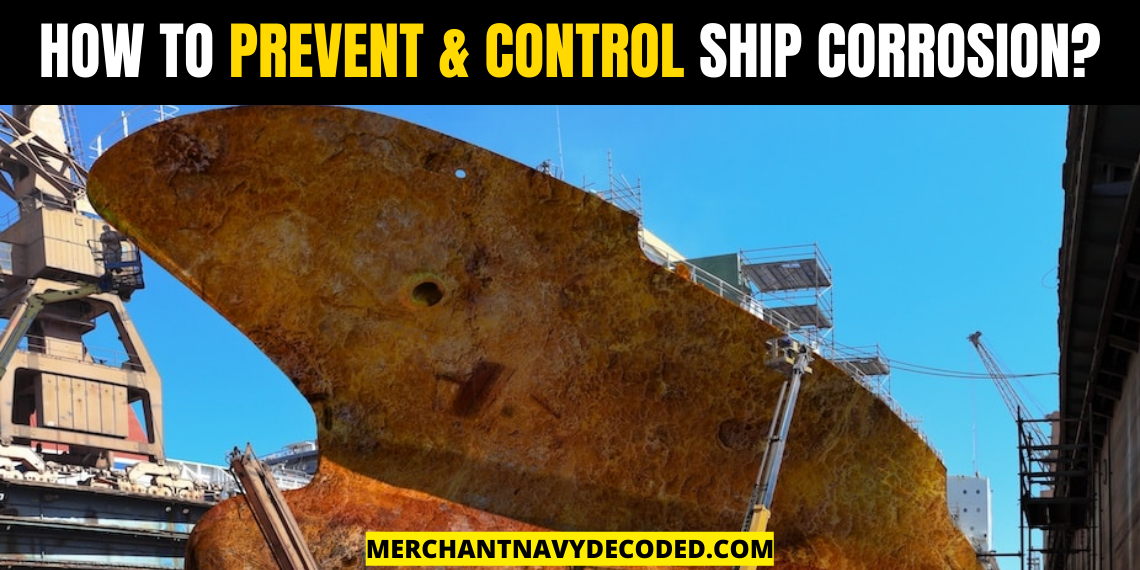How To Prevent Corrosion in Ship
1:- Corrosion in Ship Overview
Corrosion is nature’s curse on steel and other metals. It is one of the most looked-after problems in the maritime industry and through decades corrosion prevention has seen a lot of changes. If left unchecked, corrosion can eat up metal structures from the inside out and this may in turn lead to structural failures, increased maintenance costs, and even environmental pollution.
The fundamental idea of corrosion prevention at sea is ‘Prevention is better than Cure’. If you are too late, then the damage would have already been done. This is called Preventive Maintenance. ‘
We will primarily focus on corrosion prevention methods applied at sea while touching on some of the basic concepts of corrosion.
2:- What is Corrosion?
Corrosion is an electrochemical reaction between metal & the environment (oxygen & water), which results in the degradation of the metal. Metal, Air, and Oxygen are three sides of the corrosion triangle. Remove one of the sides, and you have successfully prevented corrosion.
Corrosion occurs due to the principles of the Galvanic Cell. For corrosion to occur, 4 elements are needed:
- Anode: The Metal, that undergoes oxidation or loses electrons is the anode
- Cathode: The air or water that accepts the electron is the cathode and undergoes reduction
- Electrolyte: The saltwater or moisture-laden air acts as a Conductor of the current
- Return Current Path: The underlying metal substrate often acts as the constant metallic pathway that connects the cathode and the anode.
The primary use of mild steel in ship construction is what makes corrosion prevention difficult.
3:- Factors Affecting Corrosion at Sea
What makes corrosion prevention a much more difficult task at sea, is the harsh nature of the marine environment which is a very good friend to corrosion. The following factors in the marine environment aid corrosion
Salinity: High salt content speeds up the electrochemical reaction that causes corrosion
Oxygen Concentration: The dissolved oxygen in seawater facilitates the oxidation reaction
Temperature: High Temperatures cause the metal to be more reactive, hence speeding up the corrosion reaction.
Humidity: Moisture films form on the metal surfaces due to high levels of humidity that promote corrosion.
Water Movement: Rapidly flowing water has the power to remove coatings that shield metal surfaces from more corrosive substances.
pH Levels: The rate of corrosion in saltwater can be affected by acidic or alkaline circumstances, with lower pH (more acidic water) often increasing the risk.
4:- Types of corrosion on Ship
4.1:- Galvanic Corrosion
Galvanic corrosion is caused when two dissimilar metals come into contact with each other while immersed in an electrolyte like salt water.
With dissimilar metals in seawater, the strength and direction of the action depend upon where the metals are in the galvanic series table. If the metals are close together then there is very little interaction between the two metals. If they are far apart in the table then there will be much more interaction happening. In this process, it is the more anodic metal that corrodes.
4.2:- Graphitisation of Cast Iron
This phenomenon occurs in non-alloy cast iron exposed to medium acid or soft water.
When this type of corrosion occurs, a layer of iron oxide containing graphite forms on the surface. This layer preserves the shape of the part while corrosion is taking place and, therefore, this type of corrosion cannot be detected using a visual inspection.
4.3:- Stress Corrosion

Stress corrosion occurs when a material exists in a relatively inert environment but corrodes due to applied stress. The stress may be externally applied or residual. This form of corrosion is particularly dangerous because it may not occur under a particular set of conditions until there is an applied stress.
4.4:- Fretting Corrosion

Fretting corrosion can occur when two surfaces in contact with each other undergo slight oscillatory motion, of a microscopic nature, relative to one another. Components to which this may occur are those that have been shrunk, hydraulically pressed, or mechanically tightened one to the other. The small relative motion causes the removal of metal and metal oxide films. The removed metal may combine with oxygen to form a metal oxide powder that will, in the case of ferrous metal, be harder than the metal itself thus increasing the wear. Removed metal oxide film would be repeatedly replaced increasing the damage.
4.5:- Corrosion Fatigue
Corrosion fatigue occurs when a metal is repeatedly subjected to cyclic loading, such as stress or strain, in a corrosive environment. The repeated loading causes microcracks to form on the metal surface, which can then grow and propagate over time due to the corrosive environment. These microcracks can eventually lead to macroscopic cracks, which can cause the metal to fail.
5:- Preventive Method for Corrosion in Ship
Predictive maintenance involves using sensors and other digital monitoring equipment to continuously track the condition of the ship’s structure and components.
These are essential to reduce long-term repair-related costs and maintenance.
5.1:- Design Parameters:
Early in the shipbuilding stage, the design of the ship is made such as to minimize the risk of corrosion. The following are some of the design considerations that safeguard a ship against corrosion:
- Risk Profiling and identifying the most vulnerable areas for corrosion and ensuring they are easy to inspect.
- Optimizing the scupper and drainage systems positioning to maximize water drainage. The bilge systems are also designed such that they become easy to clean and maintain.
- Corrosion-resistant alloys and the use of non-metallic materials like fiberglass-reinforced plastics in vulnerable areas and wherever possible increase the corrosion-fighting ability of the ship.
- Use of anti-vibration features and thermal insulation to reduce the stress on metal structures, which can lead to corrosion through thermal fatigue.
- Insulation between different metals helps to prevent galvanic corrosion as it restricts the flow of electrons.
5.2:- Corrosion Prevention Coatings
Corrosion-preventive coatings work by creating a protective layer between the metal surface and the corrosive environment. It prevents the corrosive elements from reaching the vulnerable metal surface.
Here are commonly used coatings on ships and their specialties:
- Epoxy Coatings: They are durable and provide excellent adhesion. They are ideal for hull protection as well as internal components.
- Polyurethane Coatings: Often used for top coats on exterior surfaces to amplify appearance due to their durability, UV Protection, and flexibility.
- Zinc-rich primers: They are commonly used as a base layer for protection. They offer sacrificial characteristics due to the electro-chemical reactivity of Zinc.
- Aluminum-Based Coatings: They are often used as an additional layer of protection and offer good corrosion resistance
- Chemical-Resistant Epoxy Coatings: Specialized for protecting internal tanks and cargo holds from chemical exposure and residues, ensuring structural integrity and safety.
5.3:- Cathodic Protection
As we already know, in an electrochemical cell, the cathode receives electrons, and the anode is depleted while releasing electrons. In the corrosion process, the metal acts as the anode. What if we can somehow convert the metal into the cathode?
Cathodic protection is the process in which the metal is protected from corrosion by converting the metal surface into a cathode of an electrochemical cell (Metal, air, and water.) It works by shifting the electrochemical potential of the metal to a level that it does not corrode and thus stops the oxidation reaction that causes corrosion.
Essentially, there are two ways to achieve this:
- Sacrificial Anode Cathodic Protection:
Zinc or Magnesium anodes are commonly used as they have more anodic potential than mild steel. These are electrically connected to the protected metal surface
As the name suggests, the sacrificial anode corrodes preferentially, thereby protecting the cathodic metal from corrosion.
- Impressed Current Cathodic Protection:
In this system, an inert anode, typically made of mixed metal oxide (MMO) coated titanium rods or platinum-coated materials is used. An external DC power source supplies pre-determined and regulated Direct Current (DC) to the protected metal. This power supply is used to maintain a protective voltage difference
An external power source provides a direct current to the protected metal, effectively counteracting the natural corrosion currents. This involves installing an inert anode and a power supply to maintain a protective voltage difference.
6:- Conclusion
This blog should have rightly pointed out the importance of corrosion prevention and informed you about how ships fight it. All of these methods may well be used in combination to offer a protective barrier to ships and their important structures.
Disclaimer :- The opinions expressed in this article belong solely to the author and may not necessarily reflect those of Merchant Navy Decoded. We cannot guarantee the accuracy of the information provided and disclaim any responsibility for it. Data and visuals used are sourced from publicly available information and may not be authenticated by any regulatory body. Reviews and comments appearing on our blogs represent the opinions of individuals and do not necessarily reflect the views of Merchant Navy Decoded. We are not responsible for any loss or damage resulting from reliance on these reviews or comments.
Reproduction, copying, sharing, or use of the article or images in any form is strictly prohibited without prior permission from both the author and Merchant Navy Decoded.



